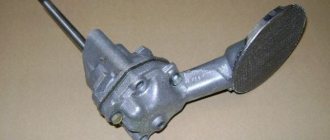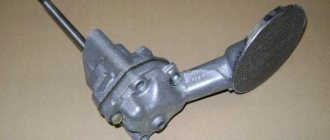If the car engine overheats or the antifreeze temperature does not reach operating temperature, the thermostat may be a possible cause of these malfunctions. There is no difference when replacing the thermostat on Lada cars (Granta, Kalina, Priora, Vesta, Largus, Niva or XRAY) with 8 and 16 valve engines, all actions are performed in the same way.
You will need : drain the coolant, prepare a flathead screwdriver, a Phillips screwdriver, a set of wrenches and silicone sealant.
Procedure:
- Remove the engine air filter housing by disconnecting the hose and the connector with the MAF wires.
- Loosen all thermostat hose clamps (their number may vary depending on the thermostat model).
- Remove the thermostat assembly by unscrewing the two screws securing it and removing the ground connector and the connector with wires from the temperature sensor.
The thermostat is installed in the reverse order, after first cleaning the seat from dirt and applying sealant. The whole process is also shown in the video:
Let us remind you that it is better to check it before installing the thermostat. If this is not the problem, check the cooling system according to the diagram.
As you know, modern cars use a special liquid to cool the power plant. The versatility of this option allows you to simultaneously provide interior heating in winter.
In order for this system to work properly, a special device called a thermostat is also installed in it. In another way, it is also called a coolant temperature regulator. One of its functions is to help the engine warm up as quickly as possible and maintain it in the required condition.
In this article we will talk about how the thermostat of a Grant car is converted to a higher response threshold (92 degrees). In addition, we will tell you about the principle of operation of this device and about possible problems that arise in it.
How does it work
Specifically in Grant, the thermostat is located between the power plant and the radiator. The main task of the unit in question is to prevent the circulation of antifreeze until the engine warms up to the required temperature. If the engine remains cold, the coolant does not move.
Ideally, the thermostat operates after the temperature of the power plant reaches 80-95 degrees. All this allows, among other things, to reduce the volume of emissions harmful to the environment and minimize engine wear.
By the way, checking the functionality of the thermostat is relatively easy. It must be placed in a container with boiling water. If the element is working properly, its valve will open approximately 20 millimeters.
Method No. 1
- We install the car within the perimeter of the repair area and secure the wheels with wheel chocks for safety purposes.
- We unscrew the plug from the expansion tank and remove the resulting vacuum.
- We loosen the clamps - ties on the distributor, pour 2.5 - 3.0 liters into a plastic container.
- Disconnect the pipes from the fittings.
Disconnecting pipes
- We unscrew the temperature sensor from the end, disconnect the ground terminal, and unscrew the two studs. Remove the antifreeze flow regulator.
- We place the product in a vice, unscrew the two screws of the cover, and remove it.
- Use pliers to press the metal spring, press it down, and remove the plate.
- After complete dismantling has been completed, we wipe the cavity of the part and carry out troubleshooting of the body.
- We install new components, replace the Lada Granta thermostat insert, and reassemble the structure.
Common faults
Despite the relative simplicity of the device, troubles sometimes occur with it. A malfunctioning thermostat will most likely render the vehicle unable to be driven. More often, its incorrect operation is provoked by the following reasons:
- unstable functioning of the motor (when tripling, the valve is often damaged);
- antifreeze getting inside the device;
- wax flows out;
- mechanical damage to the valve;
- deterioration of the rubber gasket;
However, there is usually one main reason - corrosion.
If for some reason the valve does not open at all, the coolant does not circulate and the power plant overheats. Moreover, the problem will arise regardless of how cold it is outside and how quickly the car accelerates.
Incomplete opening of the valve also causes overheating. True, in this case it will not be critical if external factors do not contribute to this. A delay in closing leads to a prolonged warm-up of the engine, and in winter it most likely will not be able to reach operating temperature.
Replacing the Grant thermostat
Over time, the device may exhaust its service life, and the valve will not operate correctly. The coolant will not be able to circulate in a large circuit and pass through the radiator. The liquid, remaining in the engine jacket, will quickly heat up and boil. In another case, the valve freezes in the open position, and the liquid constantly flows through a large circuit. The engine will take a long time to warm up. At the same time, fuel consumption will increase sharply. This is especially noticeable in cold weather. The car will need urgent thermostat replacement.
Revision option
As evidenced by reviews from grant owners, the manufacturer supplies this model with a rather weak thermostat. Usually it opens access to antifreeze after the engine warms up to 80 radii. This is due to low-quality wax inserts, which we described above.
In most cases, such a problem is not perceived as something serious, since it does not harm the operation of the engine in any way. The only drawback is that in winter, when there is frost, the interior can be cool. The situation becomes more complicated if the owner of the car switches to gas.
In this case, it makes sense to modify the thermostat so that it opens at 92 degrees. To do this you will need to purchase a new one. The entire element does not need to be replaced, so only the insert is taken out of the purchased one.
Experts advise choosing the model – VERNET TH4898.92D. Its cost is low - approximately 400 rubles.
The step-by-step replacement procedure is as follows:
- first of all, the car is driven onto a ramp or pit;
- drain antifreeze from the cooling system;
- remove the air duct because it is in the way;
- the thermostat itself is dismantled (but you can leave it in place and only remove the cover from it, the main thing is not to lose the seal);
- the old thermocouple is removed and a new one is inserted;
- they press it with the original spring and limiter.
On average, the response temperature after such a procedure increases by 15 percent.
The whole process is recorded in this video:
All cars whose engines are cooled by a special liquid have at their disposal a device called a thermostat. Lada Granta is no exception.
In the Grant model, the thermostat is located between the radiator and the engine. In the article we will talk about the concept of a car thermostat, what components it consists of and how it functions, and also consider the main types of thermostat malfunctions.
The thermostat is called the antifreeze (antifreeze) temperature regulator in the engine cooling system. It increases the engine warm-up rate and maintains the required thermal state.
The key job of the thermostat is to hold back the flow of radiator fluid until the engine has warmed up. If the engine remains cold, the coolant does not pass through it to the radiator.
The thermostat opens when the engine temperature reaches 95 degrees. Thanks to its operation, the engine warms up faster. Thus, in the Lada Granta, the thermostat reduces the amount of harmful emissions and reduces engine wear to a minimum.
If desired, you can clearly see the operation of the thermostat at home. Place the thermostat in a container filled with water, then place it on the electric stove. As the moment of boiling water approaches, the thermostat valve will open approximately 2 cm. It is recommended to experiment with a new thermostat without removing yours from your own car.
How to check Grant's thermostat
There may come a time when the vehicle stops functioning normally and phenomena such as:
- a significant increase in the warm-up time of the internal combustion engine;
- rapid boiling of the coolant after reaching a temperature of 92 °C;
- excessive fuel consumption;
- The engine does not warm up to the required temperature in winter.
In this situation, you need to know how to check the thermostat. This can be done in three ways.
- Tactile method
- Visual control
- Laboratory test
Tactile method
The engine is warmed up until the sensor readings on the instrument panel reach the desired value. Raise the hood and feel the lower radiator outlet pipe with your hand. If the device is working properly, the hose will be hot. However, the method does not provide a complete picture of the performance of the vehicle.
Visual control
The device is removed from the car and placed in a container, suspended in water. The movement of the valve will be visually visible. When the water boils, the seat will lower, revealing the hole. During cooling, the valve will, on the contrary, rise and close the passage.
Laboratory test
The thermostat is also placed in an aqueous environment, but rested on a solid base. A tripod with a dial indicator is connected to the vessel with water, the rod of which will rest rigidly on the upper valve of the vehicle. When the water is heated, the indicator readings are recorded. But this method is quite difficult to implement in a garage, so Lada Granta drivers rarely use it.
Tips for repairing a temperature control device are often published on the Internet. But this should not be done due to the fact that the device cannot be fully restored. It is best to buy and install a new thermostat on Grant.
Thermostat structure and operating conditions
The thermostat contains metals such as copper and brass alloy. The essence of the device's operation lies in a small cylinder turned towards the engine.
In the middle of the cylinder there is a synthetic wax ball, which at a certain temperature (82 degrees Celsius) begins to melt (the wax expands significantly under the influence of heat, changing its solid state to a liquid).
A special pin is pressed into the wax cylinder and is connected to a valve. When the wax melts, as a result of expansion, it begins to squeeze the pin out of the cylinder, while opening the valve through which coolant flows. When the engine stops and cools, the wax in the thermostat hardens and returns to its solid state.
Advantages of LUZAR thermostats
- Computer dosage of thermal wax LUZAR thermostats have thermal sensors filled using special equipment, which guarantees high accuracy of operation.
- Patented thermal sensor design To eliminate the possibility of a “breakthrough” of thermal wax from the thermal sensor body (which, according to statistics, is the most common cause of thermostat failure), LUZAR changed the configuration of the sealing gasket in the rod-thermal wax-cylinder interface. With increasing pressure, which expands when heated, the thermal wax gasket design - thanks to its specific geometry - forms an increased volume of rubber precisely in places where the thermal wax “breakthrough” may occur. This also required changing the geometry of the temperature sensor housing (“cylinder”).
- Rubberized valves We have eliminated the cause of insufficient tightness of the thermoelement - the metal-to-metal interface between the metal frame of the thermoelement and the metal valve plate - by using a rubber sealing gasket on the valve plate. Thus, LUZAR thermostats provide faster engine warm-up in winter (which is so important in Russian conditions climate).
- 100% control of thermoelements Each thermoelement is tested for temperature, height and response speed - carried out in special baths with cells.
- Warranty 2 years or 125,000 km. Mandatory certification In the event of a breakdown, you can easily replace the purchased thermostat through a retail store - just return it with a warranty card and a description of the defect. All products are certified according to the international quality management system ISO 9001 TUV and have GOST-R certificates of conformity.
How to tell if the thermostat is working correctly
In order to find out whether the thermostat is working or not, it is necessary to warm up the engine so that the arrow indicating the temperature does not reach the red mark of the indicator quite a bit.
After that, turn off the engine, go to the hood and open it, look for the upper radiator hose. This rubber hose is usually black in color and is approximately 5cm in diameter.
There are metal clamps at its ends. The upper hose is attached to the top of the radiator. Then we look for the lower hose. It looks like the top one, only it is attached to the bottom of the radiator.
Touch the hoses carefully; they may be hot enough to burn you. If the engine temperature indicator shows that the engine is hot, but one of the hoses is cold, then most likely the thermostat valve is closed and is not allowing coolant through the radiator.
In this case, replace the old thermostat with a new one as quickly as possible (after waiting until the engine has cooled down).
There is another “folk” method for checking the functionality of the thermostat and it is as follows. Place the thermostat in a vessel with boiled (temperature should be about 100 degrees) water.
Next, we visually observe whether the thermostat valve opens. If it opens, it means it’s working. If not, we replace the damaged one with a new one. The above method involves removing the thermostat from the car.
If the thermostat malfunctions in a car, overheating or, more often, low engine temperature is observed. Such phenomena are associated with the thermostat jamming in one position; as a result, the coolant moves in one circle (large or small). Lack of adjustment of coolant distribution leads to deviations from the engine temperature regime. Thermostat failure is one of the most common problems in a cooling system. To replace the thermostat on a Lada Granta car, the coolant from the cooling system does not need to be completely drained.
You will need: TORX TZO wrench, 13mm socket, Phillips-blade screwdriver.
Features of the LADA Granta cooling system
As in previous LADA models, upon reaching a certain temperature, the thermostat switches the coolant flow from a small to a large circuit. The small circuit includes:
- cylinder water jacket;
- water pump;
- interior heater.
The difference is that the heater radiator is connected to a small circuit in series and not in parallel. This forces all the coolant to pass through it, improving the heating of the cabin. The thermostat opening temperature is 85 degrees. Upon reaching this mark, the valve opens and the liquid begins to circulate through a large circuit into which. In addition to the small circuit elements, a cooling radiator is included. The advantage of the modernized cooling system is that antifreeze from the engine jacket falls directly onto the thermostat thermocouple without mixing in its housing. This allows the element to respond to the actual engine temperature, opening on time and preventing overheating. The manufacturer has set the permissible thermostat opening range to 85–7 degrees. That is, it can open at both 78 and 93 degrees. According to the official letter from the manufacturer, sent to dealers, the operating temperature of the Grant engine may be 10 degrees lower than that of previous VAZ models. This does not mean that the engine is “underheated” and does not lead to an increase in fuel consumption, deterioration of lubrication and a decrease in engine life. However, owners of the LADA Grant often change the thermostat to a new one, with an opening temperature closer to 90 degrees, or modify the standard thermostat by changing the thermal element.
Removing the thermostat Lada Granta
The thermostats of the 8-valve engines and the 16-valve Lada Granta engine are located differently, and therefore their replacement for these engines is shown separately. To remove the thermostat of the VAZ-11183, VAZ-21116 and VAZ-11186 engines, do the following: 1. Remove the plug from the expansion tank. Unscrew the drain plug at the bottom of the right radiator tank. Drain the coolant that comes out of the engine radiator into a container. Screw the drain plug back in.2. Release the clamp on the coolant temperature sensor wiring harness. 3. ...and disconnect the block from the sensor
4. Loosen the clamp securing the rear hose to the thermostat cover...
5. ...and remove the hose from the cover fitting
6. Similarly, disconnect the front hose from the thermostat housing pipe.
7. Unscrew the nut securing the ground wire to the upper stud securing the thermostat housing...
8. ...and remove the nut, washer and wire end from the stud.
Installation location of the Grant thermostat
The location of the vehicle may be slightly different in Grant cars with 8 and 16 valve engines. The device is located on the side of the cylinder block. It is attached with its seat to the outlet hole of the engine jacket through a gasket. The device is secured with three nuts on studs installed in the body of the motor housing.










